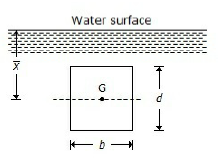If the depth of water in an open channel is less than the critical depth, the flow is called
Critical flow
Turbulent flow
Tranquil flow
Torrential flow
Correct Answer :
D. Torrential flow
Related Questions
The kinematic viscosity is the
Ratio of absolute viscosity to the density of the liquid
Ratio of density of the liquid to the absolute viscosity
Product of absolute viscosity and density of the liquid
Product of absolute viscosity and mass of the liquid
The property by virtue of which a liquid opposes relative motion between its different layers is called
Surface tension
Coefficient of viscosity
Viscosity
Osmosis
The unit of kinematic viscosity in S. I. units is
N-m/s
N-s/m2
m2/s
N-m
Steady flow occurs when
The direction and magnitude of the velocity at all points are identical
The velocity of successive fluid particles, at any point, is the same at successive periods of time
The magnitude and direction of the velocity do not change from point to point in the fluid
The fluid particles move in plane or parallel planes and the streamline patterns are identical in each plane
A vertically immersed surface is shown in the below figure. The distance of its centre of pressure from the water surface is 
(bd²/12) + x
(d²/12 x) + x
b²/12 + x
d²/12 + x
Gradually varied flow is
Steady uniform
Non-steady non-uniform
Non-steady uniform
Steady non-uniform
The pressure at a point 4 m below the free surface of water is
19.24 kPa
29.24 kPa
39.24 kPa
49.24 kPa
For a floating body to be in stable equilibrium, its metacentre should be
Below the center of gravity
Below the center of buoyancy
Above the center of buoyancy
Above the center of gravity
The sheet of water flowing over a notch or a weir is known as
Sill or crest
Nappe or vein
Orifice
None of these
The specific gravity of water is taken as
0.001
0.01
0.1
1
A vertical wall is subjected to a pressure due to one kind of liquid, on one of its sides. The total pressure on the wall acts at a distance __________ from the liquid surface.
H/3
H/2
2H/3
3H/4
When the water level on the downstream side of a weir is above the top surface of a weir, the weir is known as
Narrow-crested weir
Broad-crested weir
Ogee weir
Submerged weir
In one dimensional flow, the flow
Is steady and uniform
Takes place in straight line
Takes place in curve
Takes place in one direction
The ratio of the inertia force to the viscous force is called
Reynold's number
Froude's number
Weber's number
Euler's number
Metacentric height is given as the distance between
The center of gravity of the body and the metacentre
The center of gravity of the body and the center of buoyancy
The center of gravity of the body and the center of pressure
Center of buoyancy and metacentre
Free surface of a liquid behaves like a sheet and tends to contract to smallest possible area due to the
Force of adhesion
Force of cohesion
Force of friction
Force of diffusion
The total energy of a liquid particle in motion is equal to
Pressure energy + kinetic energy + potential energy
Pressure energy - (kinetic energy + potential energy)
Potential energy - (pressure energy + kinetic energy
Kinetic energy - (pressure energy + potential energy)
An open tank containing liquid is moving with an acceleration on an inclined plane. The inclination of the free surface of the liquid will be __________ to the acceleration of the tank.
Equal to
Directly proportional
Inversely proportional
None of these
The loss of head due to friction in a pipe of uniform diameter in which a viscous flow is taking place, is (where RN = Reynold number)
1/RN
4/RN
16/RN
64/RN
The resultant of all normal pressures acts
At C.G. of body
At center of pressure
Vertically upwards
At metacentre
The velocity at which the flow changes from laminar flow to turbulent flow is called
Critical velocity
Velocity of approach
Sub-sonic velocity
Super-sonic velocity
The difference of pressure between the inside and outside of a liquid drop is
p = T × r
p = T/r
p = T/2r
p = 2T/r
The total pressure force on a plane area is equal to the area multiplied by the intensity of pressure at the Centroid, if
The area is horizontal
The area is vertical
The area is inclined
All of the above
The siphon will work satisfactorily, if the minimum pressure in the pipe is __________ vapour pressure of liquid.
Equal to
Less than
More than
None of these
Bulk modulus of a fluid __________ as the pressure increases.
Remain same
Decreases
Increases
None of these
The units of dynamic or absolute viscosity are
Metres² per sec
kg sec/meter
Newton-sec per meter
Newton-sec² per meter
A balloon lifting in air follows the following principle
Law of gravitation
Archimedes principle
Principle of buoyancy
All of the above
The coefficient of discharge for an external mouthpiece is
0.375
0.5
0.707
0.855
When the coefficient of discharge (Cd) is 0.623, then the general equation for discharge over a rectangular weir is
1.84 (L - 0.1nH)H3/2
1.84 (L - nH)H2
1.84 (L - 0.1nH)H5/2
1.84 (L - nH)H3
If a body floating in a liquid returns back to its original position, when given a small angular displacement, the body is said to be in
Neutral equilibrium
Stable equilibrium
Unstable equilibrium
None of these
